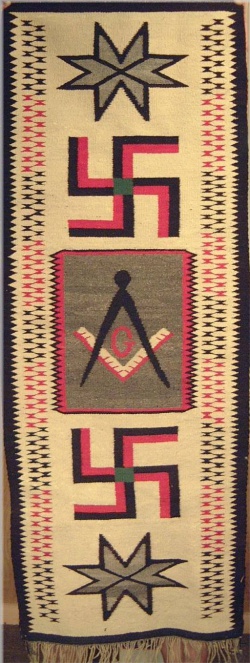En: Navajo indian rug: Unterschied zwischen den Versionen
Keine Bearbeitungszusammenfassung |
K (Kategorisierung berichtigt) |
||
| (2 dazwischenliegende Versionen von 2 Benutzern werden nicht angezeigt) | |||
| Zeile 1: | Zeile 1: | ||
[[Datei:Navajo Indian Rug.jpg|right|250px]] | [[Datei:Navajo Indian Rug.jpg|right|250px]] | ||
== Navajo indian rug == | == Navajo indian rug == | ||
Source: [[Phoenixmasonry]] | |||
'''Source: [[Phoenixmasonry]]''' | |||
This lovely rug is Navajo Indian and has a Masonic Square and Compasses in the middle, and a fylfot / swastika on either side. It also has the Navaho sign for peace on the outer ends. It was probably made for the tourist trade. It dates from the 1920’s or 1930’s and measures 61 inches long by 22½ inches across. | This lovely rug is Navajo Indian and has a Masonic Square and Compasses in the middle, and a fylfot / swastika on either side. It also has the Navaho sign for peace on the outer ends. It was probably made for the tourist trade. It dates from the 1920’s or 1930’s and measures 61 inches long by 22½ inches across. | ||
The fylfot is an ancient symbol well known in the science of coats of arms and the other details of heraldry. It is sometimes known as the cruz dissimulata, found in the catacombs of Rome, and forms one of the symbols of the Degrees of Prince of Mercy, Scottish Rite system. It is a form of the Swastika. This symbol is also called the Jaina Cross and is used by several Orders. It is found in the abbeys of Great Britain and on the monuments of India. Its significations are many. This cross was adopted by the Jainas, a heterodox sect of the Hindu's, who dissent from Brahmanism and deny the Vedas, and whose adherents are found in every province of Upper Hindustan. They are wealthy and influential, and form an important division of the population of India. This symbol is also known as the fylfot or swastika. It is a religious symbol mentioned by Weaver in his Funeral Monuments, by Dr. H. Schliemann as having been found in the presumed ruins of Troy, by De Rossi and others in the catacombs of Christian Rome, and there termed the Cruz dissimulata, or concealed cross. It has been found on almost every enduring monument on the globe, of all ages, and in both hemispheres. | The fylfot is an ancient symbol well known in the science of coats of arms and the other details of heraldry. It is sometimes known as the '''cruz dissimulata''', found in the catacombs of Rome, and forms one of the symbols of the Degrees of Prince of Mercy, Scottish Rite system. It is a form of the Swastika. This symbol is also called the Jaina Cross and is used by several Orders. It is found in the abbeys of Great Britain and on the monuments of India. Its significations are many. This cross was adopted by the Jainas, a heterodox sect of the Hindu's, who dissent from Brahmanism and deny the Vedas, and whose adherents are found in every province of Upper Hindustan. They are wealthy and influential, and form an important division of the population of India. This symbol is also known as the fylfot or swastika. It is a religious symbol mentioned by Weaver in his Funeral Monuments, by Dr. H. Schliemann as having been found in the presumed ruins of Troy, by De Rossi and others in the catacombs of Christian Rome, and there termed the Cruz dissimulata, or concealed cross. It has been found on almost every enduring monument on the globe, of all ages, and in both hemispheres. | ||
== See also == | == See also == | ||
*[[Indianer als Freimaurer]] | *[[Indianer als Freimaurer]] | ||
{{SORTIERUNG:Navajo}} | |||
[[Kategorie:English]] | |||
Aktuelle Version vom 1. August 2017, 09:47 Uhr
Source: Phoenixmasonry
This lovely rug is Navajo Indian and has a Masonic Square and Compasses in the middle, and a fylfot / swastika on either side. It also has the Navaho sign for peace on the outer ends. It was probably made for the tourist trade. It dates from the 1920’s or 1930’s and measures 61 inches long by 22½ inches across.
The fylfot is an ancient symbol well known in the science of coats of arms and the other details of heraldry. It is sometimes known as the cruz dissimulata, found in the catacombs of Rome, and forms one of the symbols of the Degrees of Prince of Mercy, Scottish Rite system. It is a form of the Swastika. This symbol is also called the Jaina Cross and is used by several Orders. It is found in the abbeys of Great Britain and on the monuments of India. Its significations are many. This cross was adopted by the Jainas, a heterodox sect of the Hindu's, who dissent from Brahmanism and deny the Vedas, and whose adherents are found in every province of Upper Hindustan. They are wealthy and influential, and form an important division of the population of India. This symbol is also known as the fylfot or swastika. It is a religious symbol mentioned by Weaver in his Funeral Monuments, by Dr. H. Schliemann as having been found in the presumed ruins of Troy, by De Rossi and others in the catacombs of Christian Rome, and there termed the Cruz dissimulata, or concealed cross. It has been found on almost every enduring monument on the globe, of all ages, and in both hemispheres.

